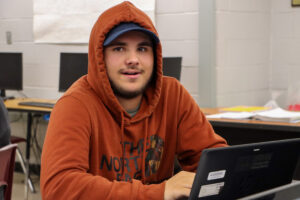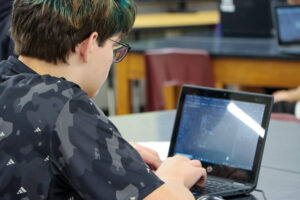
Computer Science Learning Opportunities for Linn-Mar Students
Computer Science Education Week is December 9-15 and Linn-Mar wants to celebrate the educational opportunities we offer for students.
Statewide Effort to Increase Student Access to Computer Science
Iowa’s Board of Education adopted statewide computer science standards in 2018 which created student learning goals related to computer science education. These goals are divided into core concepts, or what students should know, and core practices, or what students should do, by grade level.
 According to the National Bureau of Economic Research, 34 percent of Iowa’s college age graduates leave the state. Only eight other states in the United States have a larger number of college graduates leaving their states compared to Iowa. “Computer Science lets students hone their problem solving skills, and it also taps their creativity, because there’s no single way to tackle a programming challenge or to create a work of art by writing code,” says Dan Niemitalo, Linn-Mar High School’s lead computer science teacher. “At one level, programming involves logical and mathematical thinking, but it also requires grit, creativity, planning, and evaluating different strategies for solving a difficult problem or creating something cool.”
According to the National Bureau of Economic Research, 34 percent of Iowa’s college age graduates leave the state. Only eight other states in the United States have a larger number of college graduates leaving their states compared to Iowa. “Computer Science lets students hone their problem solving skills, and it also taps their creativity, because there’s no single way to tackle a programming challenge or to create a work of art by writing code,” says Dan Niemitalo, Linn-Mar High School’s lead computer science teacher. “At one level, programming involves logical and mathematical thinking, but it also requires grit, creativity, planning, and evaluating different strategies for solving a difficult problem or creating something cool.”
Grade-Appropriate Computer Science Exploration
Linn-Mar has made significant efforts to increase student access to computer science learning.
At the elementary level, Linn-Mar is introducing foundational coding concepts through interactive platforms that allow students hands-on access to personalize their learning. Teachers might guide students through engaging game-like activities that help foster creativity and logical thinking. These engaging lessons are loved by students, who are eager to jump in and ‘play’ in a way that helps them build a foundational knowledge of basic computer science concepts like programming, coding, algorithms and computer science principles.
These efforts are often embedded with day-to-day learning in traditional classrooms. Linn-Mar’s elementary buildings often combine computer science education with learning in their libraries. These efforts start by helping students learn computer science vocabulary, then include hands-on learning with that lesson. “For example, students at our building learned the term ‘algorithm’, and then were able to create their own algorithm to lead their partners through the library,” explained Echo Hill Teacher Librarian Katie Merulla. Katie explained that lessons look a little different from building to building, allowing librarians to customize their students’ learning based on their own space, resources, and the developmental needs of their students.
 By the time students reach middle school, they have opportunities to engage in more structured courses that cover topics such as programming basics, robotics, and digital citizenship. During these classes students are able to build on their knowledge of coding and troubleshooting with tools as they grow in skill and knowledge, all through a hands-on approach.
By the time students reach middle school, they have opportunities to engage in more structured courses that cover topics such as programming basics, robotics, and digital citizenship. During these classes students are able to build on their knowledge of coding and troubleshooting with tools as they grow in skill and knowledge, all through a hands-on approach.
Linn-Mar middle school science classes also engage with computer science hands-on projects that combine design and real-world problem solving. In some of the eighth grade classrooms students are not only learning how to conceptualize and create applications but also working on practical projects, such as designing toys for children with disabilities. This winter students also learned how to use tools in a design program to recreate a birdhouse based on specific measurements, and then printed a 3D replica of the birdhouse.
At the high school level, Linn-Mar offers more extensive computer science curriculum for students. Beginning their freshman year students can choose from introductory classes that embed computer science to those that offer more advanced programming languages, data structures, and learning about computer systems and networks. These courses not only prepare students for college-level coursework but some also offer the chance for students to earn college credit, making them an attractive option for high school students.
The courses available at Linn-Mar High School teach students programming languages, data science, game development. Students are able to earn college credits for some of these courses, but the primary focus is on providing hands-on experience and introducing computer science as a potential career pathway.
“It’s really fun to see the students’ progress after a semester of striving for mastery in the various skills involved in programming,” commented Niemitalo. “They work very hard at it, but a lot of them have a lot of fun, too. It’s a joy to teach students who love to program, and those kids will probably be the best programmers when they become professionals.”
Extending Computer Science Learning Opportunities
 Linn-Mar has grown its learning opportunities beyond the courses available in the traditional classroom as well. Students have access to after-school programs like First Lego League, First Tech Challenge, and Robotics Teams that allow them to apply their computer science knowledge and explore advanced concepts in practical settings.
Linn-Mar has grown its learning opportunities beyond the courses available in the traditional classroom as well. Students have access to after-school programs like First Lego League, First Tech Challenge, and Robotics Teams that allow them to apply their computer science knowledge and explore advanced concepts in practical settings.
Marion Economic Development Corporation has played an important role in expanding student awareness in computer-science related needs and careers. “MEDCO has allowed students access to business and industry leaders, guest speakers, career fairs, and attendance at STEM institutes,” commented Mark Hutcheson, Director of High School Teaching and Learning, Director of Venture Academics. “These community partnerships are critical in helping to prepare current learners for post secondary opportunities.”
Computer Science Showcase
 Linn-Mar Sophomore Pierson Baker is taking Computer Science Principles at the high school this year. His beginning project for this semester included creating a stock market simulation game. The game allows players opportunities to buy, sell or hold individual stocks as the game mimics the ebbs and flow of the daily stock market. “I first created a game like this as a freshman,” Pierson said “but since then I’ve changed the code to make it a more realistic experience with price changes.” Pierson says computer science is one of his favorite classes, and he hopes to work in avionics programming as a future career.
Linn-Mar Sophomore Pierson Baker is taking Computer Science Principles at the high school this year. His beginning project for this semester included creating a stock market simulation game. The game allows players opportunities to buy, sell or hold individual stocks as the game mimics the ebbs and flow of the daily stock market. “I first created a game like this as a freshman,” Pierson said “but since then I’ve changed the code to make it a more realistic experience with price changes.” Pierson says computer science is one of his favorite classes, and he hopes to work in avionics programming as a future career.


